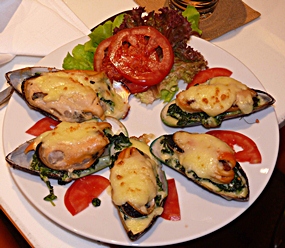Did you know that some of the highest paid professional photographers are those who photograph food?
Ask food and wine critics about menus. What is the best style and layout of a menu? Menus that have photographs in them. It is all very well having ‘vol au vent’ on the menu, but if the diner doesn’t know what it is, he is not going to order it. With international clientele in Pattaya, where English may not be their language, only a photograph can tell them what is on your menu.
OK, so there needs to be a photograph, but if that final photograph does not make the food look appetizing, the diner isn’t going to order it anyway – and will probably go somewhere else to eat next time.

Photography is one of the least truthful pastimes you can take up. For the pro photographer much of the time is used in working out how to either show the product in a favorable way, or to disguise some defect or other. There is a veritable army of people out there who love to go through advertising brochures and look for minute imperfections and write to the manufacturer saying “Do all of your watches have scratches on them?” And who gets the blame? Not the manufacturer who sent over the product, but the poor old photographer, that’s who. This can really be an enormous problem when you may be photographing a pre-production item and this is the only one in captivity.
And so to the food. This is one area where there are more fraudulent practices than any other. Cold food can be made to look hot by sprinkling chips of dry ice to give “steam” coming off the dish. Not palatable, but it looks OK. Cooking oil gets brushed on slices of the cold meat so that they look moist and succulent.
That is just for starters. In the commercial photography studio, the dedicated food photographer would erect a “light tent” of white polystyrene and bounce electronic flash inside. Brightness is necessary to stop the food looking grey and dull. If you want a “warm” look to the food, then you can use internal reflector tungsten bulbs as well, but be warned, that if you use the tungsten light as the sole source the food will turn out very orange. Lighting is just so important. If you do not have bright sparkly light then potatoes will look grey, and even the china plates look drab and dirty.
But let’s get back to a few examples where the food photographer has to stretch the truth somewhat. Ever tried photographing champagne? There’s never enough bubbles to keep Art Directors happy, so the photographer drops some sugar into the glass. Only a few grains are enough to give the almost still glass of champers that “just opened” fizz look to it. You also have to bring the light in from the back of the glass, as well as from the front. This takes two flash heads, or at least one head and a reflector.
While still on wines, if you try and shoot a bottle of red wine, it comes out thick dark maroon or even black. Professional restaurateurs but amateur photographers who have tried photographing their own wines will agree. So what does the pro shooter do? Well he has a couple of courses of action. First is to dilute the red wine by about 50 percent and secondly place a silver foil reflector on the back of the bottle. So what happens to the half bottle of red that was removed to dilute the wine? The photographer has it with dinner.
In places such as the USA, there are very firm rules about photographing food. Mainly the fact that you are not allowed to use substitute materials which “look” like food, but are actually not. This covers the old trick of using shaving cream as the “cream” on top of cappuccino coffee for example, or polystyrene foam as “ice cream”. Personally I think this is a load of ballyhoo, because the photograph is just to represent what the food will look like – you don’t eat a photograph, now do you!
Never believe everything you see!




